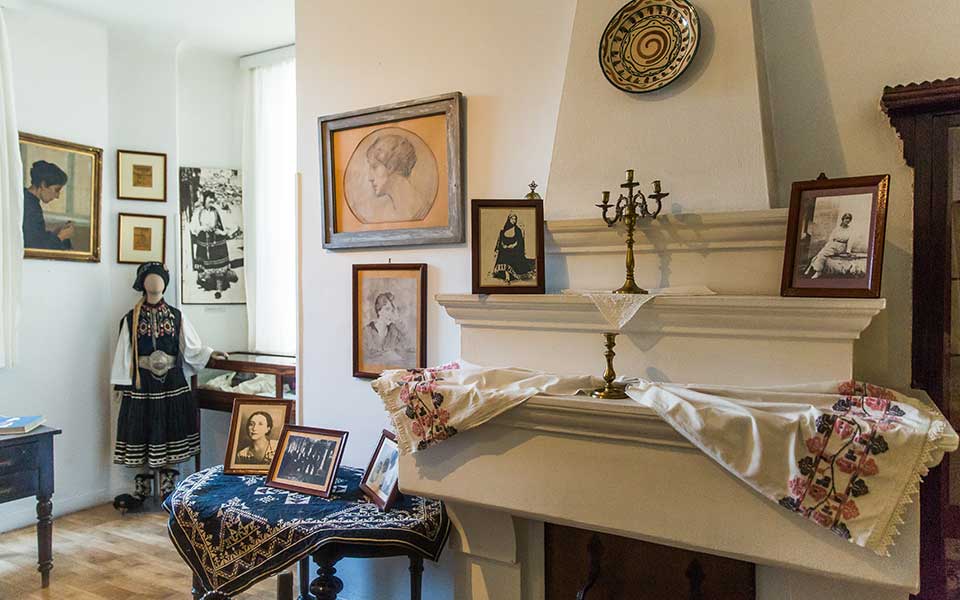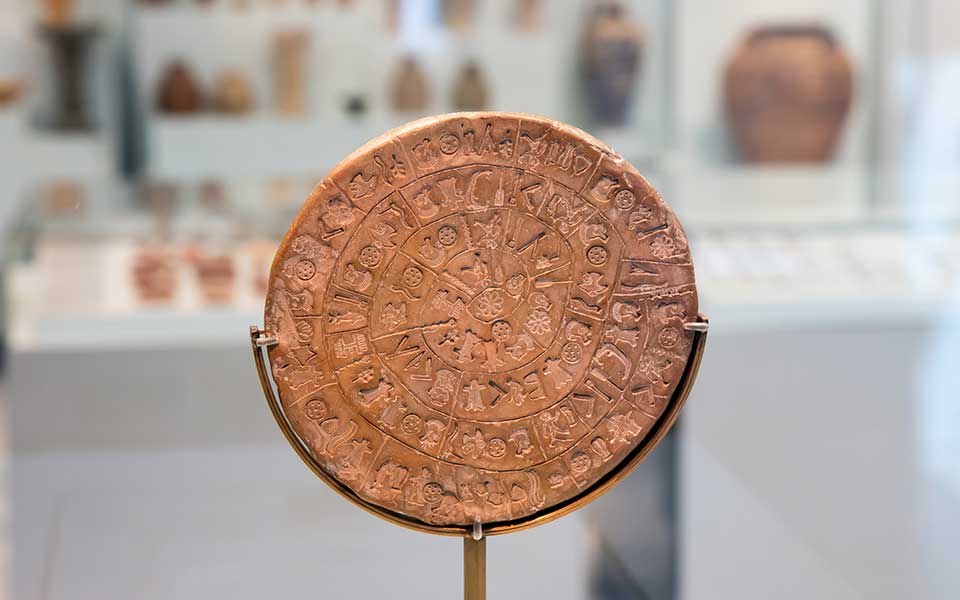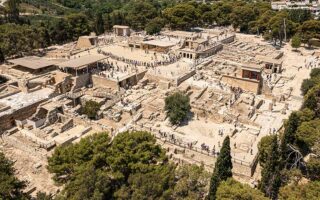12 must-visit Greek museums for 2024

When it comes to choosing where to go and what to see in Greece, it’s easy to feel overwhelmed. As far as museums go, you’re spoilt for choice, but, and let’s be honest here, not all museums are created equal.
In the following list, we’ve cobbled together a selection of 12 of the country’s top archaeological, Byzantine and modern museums, one for each month of the year, to get you inspired for your next trip to Greece. All of these museums, located in different regions of the mainland and islands, showcase emblematic exhibits and artifacts that run the full gambit of Greece’s prehistory and history, as well as rare finds and lesser-known masterpieces.
As ever, this list is in no particular order, but we hope it will get you started.

Museum of Prehistoric Thera
The Museum of Prehistoric Thera (Santorini) is an extension to the world-famous archaeological site of Akrotiri, the “Pompeii of the Aegean.” Inaugurated in the year 2000, this modern Museum houses spectacular finds from the Bronze Age settlement, which was buried under layers of ash following a powerful volcanic eruption in the late 17th century BC, including well-preserved wall frescoes and portable objects (marble figurines, pottery, bronze implements, and so on).
The Museum also hosts objects dating as far back as the 5th millennium BC, charting the course of cultural development in the Aegean region from the Neolithic (New Stone Age) to Akrotiri’s seismic destruction. The permanent exhibition also showcases the excavation of the site by renowned Greek archaeologist Spyridon Marinatos, as well as a detailed history of the island’s complex and dynamic geology.
Look out for: the amazing Flotilla Fresco, depicting a highly detailed procession of ships (c. 1650-1600 BC).
INFO
Fira, Santorini
Tel. (+30) 22860.254.05

Archaeological Museum of Olympia
One of the most important museums in Greece, the Archaeological Museum of Olympia is located near the Hiera Altis (Sacred Grove), the most glorious sanctuary of Greek antiquity, dedicated to Zeus, and the birthplace of the Olympic Games.
Built in 1966-1975, and extensively renovated in 2003-2004 in light of Athens Olympic Games, the Museum has 12 rooms, showcasing spectacular finds from the ancient sanctuary. The exhibits are organized thematically and chronologically from prehistoric times to late antiquity, and include sculptural decoration that once adorned the colossal Temple of Zeus (completed c. 463 BC), the famous Nike of Paionios (c. 425-420 BC), and the statue of Hermes and infant Dionysus by the sculptor Praxiteles (4th century BC).
Look out for: the bronze Corinthian helmet bearing a dedicatory inscription of the general Miltiades to Zeus. Miltiades masterminded the Athenian-led victory over the Persians at the Battle of Marathon, in 490 BC.
INFO
Ancient Olympia
Tel. (+30) 26240.227.42

Museum of Byzantine Culture
Inaugurated in 1994, the Museum of Byzantine Culture in the northern Greek city of Thessaloniki is considered one of the best examples of public architecture in Greece – the first museum in the country to be awarded the prestigious Council of Europe’s Museum Prize in 2005.
Eleven rooms showcase the Museum’s permanent collection, presented and organized into thematic units through over 3,000 exhibits, dated between the 2nd and 20th centuries. Most of the artifacts hail from the historic city of Thessaloniki, while others comes from the wider region of Macedonia. The Museum also has an independent wing, used to house temporary exhibitions, as well as a space dedicated to educational activities.
Look out for: the exquisitely detailed gold and silver embroidered “sakkos” (pontifical tunic) of the Bishop of Melenikon Ioannikios, made in the mid-18th century.
INFO
2 Stratou Avenue 2, Thessaloniki
Tel. (+30) 23133.064.00

Museum of Modern Greek Culture
Previously known as the Museum of Greek Folk Art, established in 1981, a major re-organization of the venerable old museum resulted in the opening of the brand new Museum of Modern Greek Culture in 2021, located in the heart of historic Athens. Plans are currently underway to house the new permanent exhibition in a complex of buildings that date from the 17th to the early 20th century, in a neighborhood of Monastiraki known as “the courtyard of miracles.”
Currently, the museum features two separate annexes, the Museum at 22 Panos Street, showcasing aspects of life in pre-industrial Greece in a permanent exhibition entitled “Man and Tools,” and the Bath House of the Winds on 8 Kyrristou Street, a traditional bathhouse that dates back to the first period of Ottoman rule (1453-1669).
Look out for: the shadow puppet of Erotokritos (made for shadow theater), a folk hero of Cretan poetry of the 17th century.
INFO
Archaeological Museum of Thebes
Inaugurated in 2015, the new Archaeological Museum of Thebes is hands-down the best regional museum in Greece, showcasing the rich and diverse history of Boeotia (Viotia). Your visit starts in the impressive courtyard, dominated by the ruins of a medieval tower, built in the late 13th century by the lord Nikolaos II Saint-Homer (1258-1294).
The permanent exhibition is neatly arranged in 18 sections, illustrating aspects of social and economic life in the region from the Palaeolithic (Old Stone Age) up to the Ottoman period. Special reference is made throughout to the famous ancient Greek tragedies of the Theban mythological cycle, and there is a vast array of digital applications, visual material and reconstructions. Underneath the museum is a well-preserved archaeological site, featuring an apsidal house from the 3rd millennium BC, tombs of the 17th century BC, and the foundations of the Mycenaean-era fortification wall of the Kadmeia, Thebes’ acropolis.
Look out for: the clay figurine of a man grating cheese, c. 500 BC.
INFO
1 Threpsiadou, Thebes
Tel. (+30) 22620.279.13

Archaeological Museum of Hania
The newly opened Archaeological Museum of Hania on Crete is located in the historic suburb of Halepa. The permanent exhibition presents the archaeological riches of the Hania regional unit of western Crete, from prehistoric settlements to the Ottoman period. The older museum, established in 1962, was located in the former Venetian Monastery of Saint Francis. The new museum was opened in April 2022.
The ultra modern-looking Museum features reconstructions, digital displays, and tactile exhibits, highlighting the region’s social and administrative organization through the course of time, as well as an extensive collection of objects related to religion, war, commerce, and daily life.
Look out for: the well-preserved bronze sword with ivory pommel, gold ring and rivets, dated to c. 1400-1375 BC.
INFO
15 Skra, Halepa, Hania
Tel. (+30) 28210.233.15

Archaeological Museum of Alexandroupolis
In the far northeast of Greece, the permanent exhibition of the Archaeological Museum of Alexandroupolis was inaugurated in June 2022. Its collection includes artifacts brought to light through years of excavations and surveys in the border region of Evros, part of eastern Macedonia and Thrace, an area that has been continuously settled and occupied by since at least the 6th millennium BC.
The human story in this corner of Greece is told through an impressive array of 1,000 objects, maps, photos, reconstructions and digital media, organized in three main exhibition areas: the coastal zone; from Evros to the Ardas River; and the burial tumuli (mounds).
Look out for: the glass perfume vase in the shape of a fish, found in burial tumulus B at Ladi, 1st-2nd century AD.
INFO
44 Makris Avenus, Alexandroupolis
Tel. (+30) 25510.261.03

Archaeological Museum of Delphi
Nestled amid the spectacular, rugged beauty of Fokida, Central Greece, the Archaeological Museum of Delphi is located at the foot of the most important oracle of the ancient Greek world, a UNESCO World Heritage Site since 1987. The on-site Museum has undergone major renovations and extensions since it was first erected in 1903. The latest extension was completed in 2004, enabling the Museum’s curators to update the exhibits, improve the lighting, and install state-of-the-art visual displays.
The permanent collection covers the history and monumental evolution of the Delphic sanctuary, dedicated to the god Apollo. The exhibits, spanning prehistory to late antiquity, include architectural sculptures, statues, and portable objects.
Look out for: Far too many objects to choose from, but the bronze Charioteer statue from c. 480-460 BC, is breathtaking.
INFO
Delphi, Fokida
Tel. (+30) 22650.823.12

Archaeological Museum of Mycenae
The Archaeological Museum of Mycenae is located on the north slope of the world famous citadel of Mycenae, in the northeast Peloponnese. Inaugurated in 2003, the museum is housed in a modern building with three halls, presenting some 2,500 artifacts related to the Late Bronze Age site and the spread of Mycenaean civilization. It should be noted, however, that the most impressive finds from the site, discovered during the excavations of Heinrich Schliemann in the late 19th century, are on display in Athens, at the National Archaeological Museum (see below).
Nevertheless, there are plenty of treasures on display at Mycenae, with various findings from the royal Grave Circles A and B, and from the scattered cemeteries of the nearby chamber tombs.
Look out for: The striking piriform amphora decorated with a highly stylized octopus, in the “marine style,” c. 1500-1450 BC.
INFO
Mycenae, Argolida
Tel. (+30) 27510.768.02
Xenokrateion Archaeological Museum of the Sacred City of Messolongi
Located in the heart of Messolongi, in western Greece, the Xenokrateion Archaeological Museum is housed in a spectacular 19th century neoclassical mansion, which formerly served as a municipal girl’s school.
Inaugurated in December 2021, the Museum is dedicated to the western Greek region of Aetolia and Acarnania, a periphery area with its own distinct identity and character. The permanent exhibition features more than 1,200 objects, spanning early prehistory through late antiquity, recovered from various archaeological sites.
Look out for: the beautiful gold kylix (drinking cup), found in the Late Bronze Age “Tomb of the Warrior” at Kouvaras, 14th century BC.
INFO
2 Asimaki Fotila, Messolongi
Tel. (+30) 26310.260.68

Iraklion Archaeological Museum
Regarded as one of the most important museums in Europe for the study of Bronze Age Minoan civilization, the Iraklion Archaeological Museum was built in the early 20th century over the ruins of the Venetian Monastery of Saint Francis, destroyed by an earthquake in 1856. The ruins of the monastery are still visible in the museum’s garden.
Located in the heart of Iraklio, the current museum, which underwent a major renovation program in 2014, houses artifacts from all periods of Cretan prehistory and history, spanning 5,500 years from the Neolithic period to Roman times (6th millennium BC – 3rd century AD). Along with the permanent exhibition, laid out in 27 rooms across two floors, the museum organizes temporary exhibitions from other collection in Greece and abroad.
Look out for: The enigmatic “Phaistos Disk,” a clay disk bearing 241 pictograms arranged in 61 groups – the as yet undeciphered Linear A script, c. 1550 BC.
INFO
2 Xanthoudidou and Hatzidaki, Iraklio
Tel. (+30) 2810.279.000

National Archaeological Museum of Athens
With its permanent display of some 11,000 artifacts, covering the panorama of ancient Greek culture and civilization from the 6th millennium BC to the 5th century AD, the National Archaeological Museum of Athens is the largest museum in Greece, and one of the most important in the world dedicated to ancient Greek art. No visit to Athens would be complete without at least half a day at this magnificent museum.
Founded at the end of the 19th century, the Museum is housed in an elegant neoclassical building in the Exarchia neighborhood of central Athens. It underwent an extensive renovation from 2002 to 2009, rearranging much of its permanent collection, and there are further plans for an underground extension and rooftop garden.
The exhibits are organized in seven collections: prehistoric antiquities (Neolithic, Cycladic and Mycenaean), sculptures, the vase and minor objects collection, the Santorini collection, metallurgy, a collection of Egyptian and Near Eastern antiquities, and a separate Epigraphical Museum. The Museum is also home to a rich library of archaeology books, boasting some 20,000 volumes.
Look out for: Impossible to choose. The bronze statue of Zeus or Poseidon, c. 460 BC, is as iconic as it gets, similarly the golden Death Mask of Agamemnon, from Grave Circle A at Mycenae, c. 16th century BC. The Museum is also home to the mysterious Antikythera Mechanism. Click here for our helpful guide.
INFO
44 28th Oktovriou, Athens
Tel. (+30) 213.214.4800
With information from the Hellenic Organization of Cultural Resources Development (H.O.C.RE.D)
This article appeared in Greece Is (www.greece-is.com), a Kathimerini publishing initiative.





